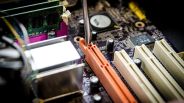The Amazon.com Inc (AMZN.O) was recently authorized by the United States federal agency to conduct research and development testing of their delivery drones, just two weeks after the e-commerce organization blasted Federal Aviation Administration (FAA) for being sluggish to make an effective business drone testing guidelines.
This company's prior request spent half a year in limbo, forcing it to take all development testing overseas. By the time the FAA allowed the drone noted in the first application to be flown within the U.S., the machine was already obsolete and Amazon was using a new model.
Paul Misener, vice president for global public policy of Amazon.com, said in written testimony at the time, "We don't test it anymore. We've moved on to more advanced designs that we already are testing abroad. Nowhere outside of the United States have we been required to wait more than one or two months to begin testing."
While Amazon is struggling with the regulatory approval, China's Alibaba Group Holdings had already launched its first trial drone deliveries in Beijing in February. The Chinese e-commerce company partnered with Shanghai YTO Express Logistics to deliver ginger tea packets to 450 Chinese customers who had volunteered for the drone delivery tests.
Based on the FAA's website, Amazon's petition to put in trial the delivery drones was granted in a memo dated April 8, 2015. It was also noted that Amazon must keep flights at an elevation of no more than 400 feet and no faster than 100 miles per hour.
Amazon has been pushing its drone delivery service called "Prime Air" since 2013. According to the company, the small unmanned aircraft is expected to deliver packages in only 30 minutes.
These delivery drones can move over 50 miles per hour and can only allow five pound payloads. Those items cover 86 percent of what Amazon currently delivers and will be flown from the company's 96 massive warehouses spread around the country.
Amazon, which is based in Seattle, Wa., has been trying to achieve the goal of sending packages to customers by air by aircraft that is self-piloted and small, in spite of safety and privacy concerns.
The e-commerce company aims to use drones for delivering packages to customers over distances of 10 miles or greater. This would require autonomously traveling drones to be fully equipped with the right technology so to avoid crashing into other aircraft.
In February, the FAA brought about rules in an attempt to set guidelines for drones in the U.S., addressing the growing interest in them by individuals and corporations alike.
Photo: Claudio Toledo | Flickr
ⓒ 2025 TECHTIMES.com All rights reserved. Do not reproduce without permission.




